Vital acts and events are the births, deaths, fetal deaths, marriages, and all such events that have something to do with an individual's entrance and departure from life together with the changes in civil status that may occur to a person during his lifetime.
Recording of these events in the civil register is known as vital or civil registration and the resulting documents are called vital records.
Vital statistics are derived from information obtained at the time when the occurrences of vital events and their characteristics are inscribed in a civil register.
7,095 CERTIFICATES OF LIVE BIRTHS REGISTERED AND PROCESS FOR THE YEAR 2021
A total of 7,095 registered certificate of Live Births by Place of Occurrence were received and processed for the year 2021 in the province of Northern Samar. It is 5.846 percent lower compared to 7,635 registered live births in 2020. (See Figure 1 and Table 1.)
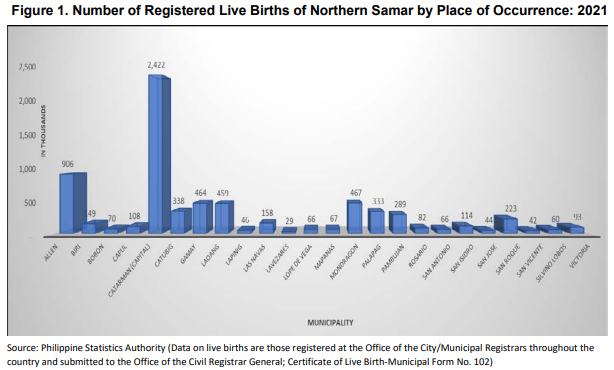
A decreased 440 registered births or 5.84 or 6 percentage point for 2021 compared to the number of registered on the previous year 2020. Lapinig recorded the highest significant decreased in birth registration with 57.41 percentage point while San Jose got the highest significant increased with 100% from year 2020 to 2021. (see table 2 below.)
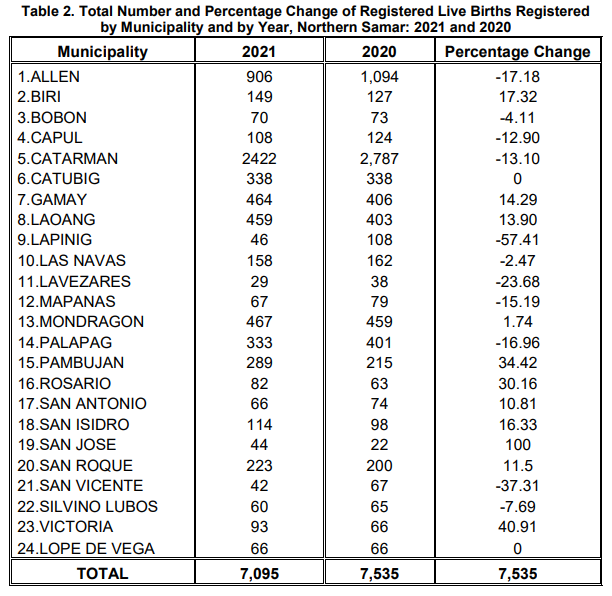
Eleven births per thousand population
In 2021, a total of 7,095 live births was registered which is equivalent to a crude birth rate (CBR) of 11.10 or 11 births per thousand population1. On the average, there were about nineteen (19) registered babies born daily or one (1) babies born per hour.
Of the total live births in Northern Samar, Catarman recorded the highest number of birth occurrences of about 34.14%, followed by Allen with 12.77% and Mondragon with 6.58%.
With only 29 registered live births for the whole year, the municipality of Lavezares deemed to have the lowest number of birth occurrences with only 0.41%. It was followed by San Vicente with 0.59% and San Jose with 0.62%
More Males born than Females in 2021
In the province, more males (3,671, 51.74% share) or more than half were born than females (3,424, 48.26% share) which comprises almost the other half of births or 44.31 percent (see figure 2). This resulted to a sex ratio at birth of 107 males per 100 females.
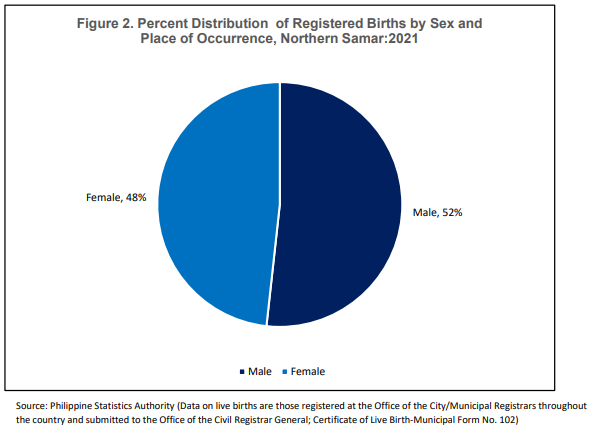
Highest Number of female and male babies born in September
By usual residence of the mother, there were 7,211 registered live births in Northern Samar in 2021. Out of this total, there were more female and male babies born in the month of September with 361 and 359 respectively. While the least number of male babies born is in the month of July with only 323 and for female is in October with 324 (See Figure 3 and table 3).
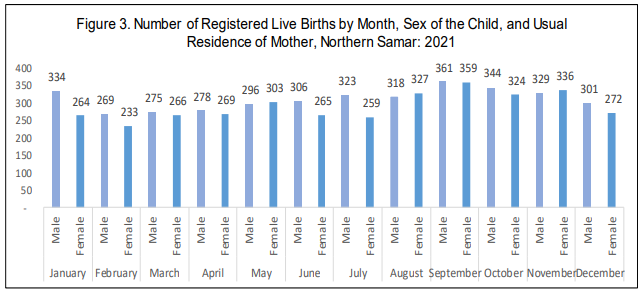
Nine in ten birth deliveries attended by Health Professionals
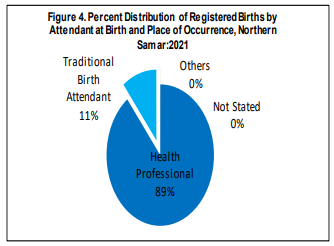
6,348 out of 7,095 or 89.47 percent of birth deliveries in 2021 in Northern Samar were attended by medical professionals such as physicians, nurses or midwives. There were 745 registered live births which were attended by traditional birth attendants (hilot/unlicensed midwife), while 2 birth deliveries were served by other attendants at birth.
Nine in ten births delivered in Health Facility
In 2021, nine out of ten births delivered in a health facility in the province Northern Samar. 6,288 births are either delivered in the hospitals (Private or Public), RHUs, Lying-In and some other birthing facilities. Only 11 percent or 806 birth deliveries were delivered at home.
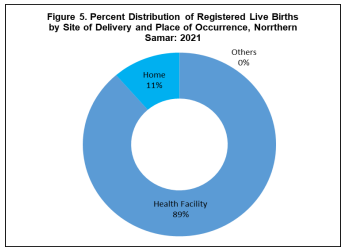
Most number of Births registered in September
In 2021, most number of births registered in the month of September at 710 or 10.01 percent of the total births in Northern Samar. It was followed by the months of October and November (9.22% share) and August (8.94% share). On the other hand, the month of February had the least number of births (6.89% share). See Figure 6 and table 4.

Majority of the babies were born to mothers ages 25-29 years old
Majority of the registered births in 2021 was delivered by mother’s ages 25-29 years old in the province with 1,948 or 27.46% share. Followed by ages 20-24 with 26.69% share and 30-34 with 1,368 or 19.28% share. See Figure 7 and Table 5.
Age group 15-19 year old with 712 or 10.04% share and younger (under 15) with 7 or 0.10% share and ages 30 year old and over with 1,166 or 16.43% share are among the high risk age for pregnant women and the figure is somewhat alarming for the province. This is because adolescent mothers (aged 10–19 years) face higher risks of eclampsia, puerperal endometritis and systemic infections than women aged 20–24 years, and babies of adolescent mothers face higher risks of low birth weight, preterm birth and severe neonatal condition. Furthermore, adolescent Pregnancy are at higher risk to get mental health problems such as depression, intense stress and pressure to become parents.
On the other hand, after age 35, there's a higher risk of pregnancy-related complications that might lead to a C-section delivery. The risk of chromosomal conditions is higher. Babies born to older mothers have a higher risk of certain chromosomal conditions, such as Down syndrome. The risk of pregnancy loss is higher for this age group.
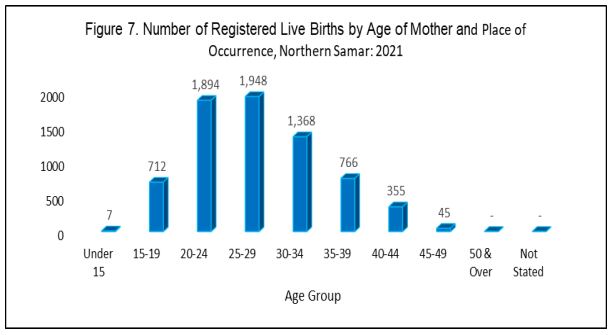
TECHNICAL NOTES
Civil Registration. It is a continuous, permanent and compulsory recording of vital events occurring in the life of an individual such as birth, marriage and death, as well as court decrees and legal instruments affecting the civil status of an individual.
Live Birth is a complete expulsion or extraction from its mother of a product of conception, irrespective of the duration of the pregnancy, which after separation, breathes or shows any other evidence of life, such as beating of the heart, pulsation of the umbilical cord, or definite movement of voluntary muscles, whether or not the umbilical cord has been cut or the placenta is attached, such a birth is considered live born.
Death is a permanent disappearance of all evidence of life at any time after live birth has taken place.
Marriage is special contract of permanent union between a man and a woman entered into in accordance with law for the establishment of conjugal and family life.
Fetal Death refers to death prior to the complete expulsion or extraction of a product of conception from its mother, irrespective of the duration of pregnancy; the death is indicated by the fact that after such separation, the fetus does not breathe or show any other evidence of life, such as beating of the heart, pulsation of the umbilical cord, and definite movement of voluntary muscles.
The Sex ratio is usually expressed as the number of males per 100 females. It may also be given as a percentage excess or deficit of males. The Gender ratio is a pretty important part of evolutionary life. Sex ratio calculation is used to describe the balance between the male and female population. In the Gender ratio calculator both the male and female ratio can be found separately or both the male and female gender ratio can be found together.
EXPLANATORY NOTES
This special release presents data on birth obtained from birth certificates registered at the Local Civil Registry Office (LCRO) all throughout the province of Northern Samar and forwarded to the Office of the Civil Registrar General. Statistics presented were not adjusted for under-registration
Prepared by:
SGD. MAE M. MORENO
Registration Officer II
Approved by:
SGD. JULIAN E. GALLANO
Registration Officer II
Chief Statistical Specialist

